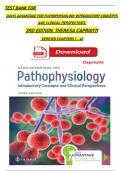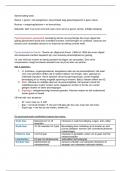TEST BANK FOR
DAVIS ADVANTAGE FOR PATHOPHYSIOLOGY INTRODUCTORY CONCEPTS
AND CLINICAL PERSPECTIVES,
3RD EDITION, THERESA CAPRIOTTI
VERIFIED CHAPTERS 1 - 42
, TABLE OF CONTENTS
I. The Cell
1. The Cell in Health and Illness
2. Cellular Injury, Adaptations, and Maladaptive Changes
3. Genetic Basis of Disease
II. Integrated Body Processes
4. Stress, Exercise, and Immobility
5. Obesity and Nutritional Imbalances
6. Pain
III. Fluid, Electrolyte, and Acid-Base Homeostasis
7. Fluid and Electrolyte Imbalances
8. Acid-Base Imbalances
IV. Infection and Inflammation
9. Inflammation and Dysfunctional Wound Healing
10. Infectious Diseases
11. Disorders of the Immune System
V. Hematologic Disorders
12. Disorders of White Blood Cells
13. Disorders of Red Blood Cells
14. Disorders of Platelets, Hemostasis, and Coagulation
VI. Disorders of Cardiovascular Function
15. Arterial Disorders
16. Ischemic Heart Disease and Conduction Disorders
17. Heart Failure
18. Valvular Heart Disease
19. Disorders of the Venous System
VII. Pulmonary Disorders
20. Respiratory Inflammation and Infection
21. Restrictive and Obstructive Pulmonary Disorders
VIII. Renal and Urological Disorders
22. Renal Disorders
23. Urological Disorders
IX. Hormonal and Reproductive Disorders
24. Endocrine Disorders
25. Diabetes Mellitus and the Metabolic Syndrome
26. Disorders of the Female Reproductive System
27. Disorders of the Male Reproductive System
28. Sexually Transmitted Infections
X. Gastrointestinal Disorders
29. Disorders of the Esophagus, Stomach, and Small Intestine
30. Common Disorders of the Large Intestine
31. Infection, Inflammation, and Cirrhosis of the Liver
,32. Gallbladder, Pancreatic, and Bile Duct Dysfunction
XI. Neurological Disorders
33. Cerebrovascular Disorders
34. Chronic and Degenerative Neurological Disorders
35. Brain and Spinal Cord Injury
36. Psychobiology of Behavioral Disorders
XII. Musculoskeletal Disorders
37. Musculoskeletal Trauma
38. Degenerative Disorders of the Musculoskeletal System
39. Infection and Inflammatory Disorders of the Musculoskeletal System
XIII. Cancer
40. Cancer
XIV. Integumentary Disorders
41. Skin Disorders
42. Burns
XV. Sensory Disorders
43. Eye Disorders
44. Ear Disorders
XVI. Aging and Multi-System Disorders
45. Pathophysiological Concepts of Aging
46. SIRS, Sepsis, Shock, MODS, and Death
,Chapter 1, The Cell in Health and Illness
Multiple Choice
Identify the choice that best completes the statement or answers the question.
1. Which statement regarding the sodium–potassium pump is correct?
1. The cell’s plasma membrane is more soluble to sodium ions than potassium ions.
2. The concentration of sodium ions should be higher inside the cell compartment.
3. The concentration of potassium ions should be higher outside the cell
compartment.
4. The active transport involves pumping out three sodium ions and pumping in two
potassium ions.
2. In the absence of oxygen, which cellular function creates the same amount of energy as is created in
the presence of oxygen?
1. Dissipation of pyruvic acid
2. Initiation of the citric acid cycle
3. Activation of acetyl-coenzyme A
4. Creation of acidosis via lactic acid
3. How many adenosine triphosphates (ATPs) are produced in aerobic energy metabolism?
1. 2
2. 3
3. 34
4. 53
4. Which cell organelles differ in their number according to the cell’s energy needs?
1. Ribosomes
2. Mitochondria
3. Ribonucleic acids
4. Deoxyribonucleic acids
5. Which option best supports the reason more energy is produced when a person is exercising?
1. Exercise causes an increase in the synthesis of protein.
2. There is an increase in the production of pyruvic acid in the cells.
3. The conversion of pyruvic acid to lactic acid is increased by exercise.
4. Muscle cells have more mitochondria to meet energy demands.
6. When does ribosomal protein synthesis cease?
1. During endoplasmic reticulum stress
2. During the synthesis of adenosine triphosphate (ATP)
3. During a severe hypoxic state
4. During the processing of prohormone
7. Which cellular organelles are responsible for propelling mucus and inhaled debris out of the lungs?
1. Cilia
2. Microfilaments
.
, 3. Secretory vesicles
4. Endoplasmic reticula
8. Which are the key proteins in the contractile units of the muscle cells?
1. Actin and myosin
2. Prohormone and tubulin
3. Tubulin and actin
4. Myosin and prohormone
9. Which deficiency causes Tay–Sachs disease?
1. Proteasome
2. Peroxisome
3. Macrophage
4. Lysosomal enzymes
10. Which is a characteristic of adrenoleukodystrophy?
1. Accumulation of ganglioside
2. Cessation of ribosomal protein synthesis
3. Acceleration of cellular proteasome activity
4. Accumulation of long-chain fatty acids in the nervous system
11. Which statement regarding endoplasmic reticulum (ER) stress is correct?
1. During ER stress, proteins are rapidly degraded.
2. During ER stress, lipids cannot travel to their proper intracellular locations.
3. During ER stress, long-chain fatty acids accumulate in the nervous system.
4. During ER stress, nondegraded substances accumulate in the cells.
12. A client is diagnosed with type 1 diabetes mellitus. At a cellular level, which function is likely to be
involved?
1. Inability of ribosomes to produce a specific type of protein
2. Incorrect processing of a protein by the Golgi apparatus
3. Stagnation of a previously dynamic action in microtubules
4. Obstruction of the smooth endoplasmic reticulum
13. A newborn patient exhibits characteristics of severe physical deformities. Which cellular component
is examined to determine the cause and probability of the disease being genetically transferred?
1. Transfer RNA
2. Ribosomal RNA
3. Double helix of DNA
4. Mitochondrial DNA
14. A hiker experiences muscle pain and acidosis while ascending a mountain during a long, steep
climb. Which is the reason for these manifestations?
1. Cellular hypoxia
2. Autolysis
3. Heterolysis
4. Cellular edema
.
, 15. Which factor provides DNA the unique molecular ability to replicate?
1. The pairing of nitrogenous bases
2. The presence of pyrimidine bases
3. The presence of nucleotides
4. The nitrogenous base and phosphate bond
16. How many nitrogenous bases compose a single codon?
1. 2
2. 3
3. 4
4. 5
17. Which components form the structure of DNA?
1. Nucleotides
2. Amino acids
3. Fatty acids
4. Phosphates
18. Which factor is essential in order for protein synthesis to occur?
1. Free-standing ribosomes within the cell
2. Protein blueprint from the cell of the DNA
3. Specific information from the nucleus of the cell
4. Transfer RNA to move the protein out of the cell
19. Tetracycline antibiotic is prescribed for an adult client with chlamydia infection. Which is the
mechanism of action of the drug?
1. It prevents the replication of bacteria.
2. It alters the configuration of bacterial cytoplasm.
3. It interferes with the function of bacterial ribosomes.
4. It inhibits the functions of bacterial mitochondria.
20. Where does the conversion of a prohormone into a hormone take place?
1. In the ribosomes
2. In the Golgi apparatus
3. In the secretory granules
4. In the endoplasmic reticulum
21. Which is the cell’s “master mind”?
1. Nucleus
2. Ribosome
3. Golgi apparatus
4. Endoplasmic reticulum
Multiple Response
Identify one or more choices that best complete the statement or answer the question.
22. Which statements regarding the microtubules are true? Select all that apply.
.
, 1. Microtubules are solid.
2. Microtubules are flexible.
3. Microtubules are composed of tubulin.
4. Microtubules are called actin filaments.
5. Microtubules have structures involved in cell division.
23. Which cellular actions are carried out during the process of protein synthesis? Select all that apply.
1. DNA directs the cell to carry out the process.
2. Transcription occurs in the ribosome of the cell.
3. Protein translation takes place in the cell nucleus.
4. RNA is single-stranded and travels outside the nucleus.
5. In RNA, the pyrimidine base thymine is replaced with uracil.
24. Which characteristics are specific to RNA during protein synthesis? Select all that apply.
1. Presence of ribose pentose sugar
2. Presence of single-stranded helix
3. Presence of double-stranded helix
4. Presence of deoxyribose pentose sugar
5. Presence of uracil and cytosine as a pyrimidine base
25. Which are the purine bases found in DNA? Select all that apply.
1. Uracil
2. Adenine
3. Guanine
4. Thymine
5. Cytosine
.
,Chapter 1, The Cell in Health and Illness
Answer Section
MULTIPLE CHOICE
1. ANS: 4
Chapter: Chapter 1, The Cell in Health and Illness
Objective: Recognize the major organelles and their function within the cell.
Page: 1
Heading: Cell Structure and Function>The Sodium Potassium Pump (Na+/K+ Pump)
Integrated Process: Nursing Process
Client Need: Physiological Integrity: Physiological Adaptation
Cognitive Level: Comprehension [Understanding]
Concept: Cellular Regulation
Difficulty: Moderate
Feedback
1 This is incorrect. The plasma membrane of the cell is less soluble to sodium ions
and more soluble to potassium ions.
2 This is incorrect. The concentration of sodium ions should be higher outside the
cell compartment.
3 This is incorrect. The concentration of potassium ions should be higher inside
the cell compartment.
4 This is correct. In active transport, for every three sodium ions pumped out, two
potassium ions are pumped in.
PTS: 1 CON: Cellular Regulation
2. ANS: 2
Chapter: Chapter 1, The Cell in Health and Illness
Objective: Discuss the difference between aerobic and anaerobic metabolism.
Page: 3
Heading: Cell Structure and Function>Energy Metabolism
Integrated Process: Nursing Process
Client Need: Physiological Integrity: Physiological Adaptation
Cognitive Level: Analysis [Analyzing]
Concept: Cellular Regulation
Difficulty: Difficult
Feedback
1 This is incorrect. When oxygen is not available, anaerobic metabolism produces
significantly less cellular energy: a net yield of 2 ATP, as well as pyruvic acid.
2 This is correct. In the absence of oxygen, pyruvic acid is converted into acetyl-
coenzyme A, which triggers a series of reactions known as the Krebs cycle, also
.
, called the citric acid cycle.
3 This is incorrect. Pyruvic acid is converted into acetyl-coenzyme A, not
activated.
4 This is incorrect. In cellular hypoxia, pyruvic acid is converted to lactic acid,
which is noxious to cells, causing muscle pain and biochemical alterations such
as acidosis.
PTS: 1 CON: Cellular Regulation
3. ANS: 3
Chapter: Chapter 1, The Cell in Health and Illness
Objective: Discuss the difference between aerobic and anaerobic metabolism.
Page: 3
Heading: Cell Structure and Function>Energy Metabolism
Integrated Process: Nursing Process
Client Need: Physiological Integrity: Physiological Adaptation
Cognitive Level: Knowledge [Remembering]
Concept: Cellular Regulation
Difficulty: Easy
Feedback
1 This is incorrect. In anaerobic energy metabolism, 2 ATPs and pyruvic acid are
produced.
2 This is incorrect. In active transport, 3 sodium ions are pumped out. This takes
place in the plasma membrane.
3 This is correct. The process of aerobic energy requires oxygen and provides the
maximum amount of energy for cellular function. The process yields 34 ATPs.
4 This is incorrect. Aerobic energy metabolism produces 34 ATPs, not 53.
PTS: 1 CON: Cellular Regulation
4. ANS: 2
Chapter: Chapter 1, The Cell in Health and Illness
Objective: Recognize the major organelles and their function within the cell.
Page: 3
Heading: Cell Structure and Function>Mitochondria
Integrated Process: Nursing Process
Client Need: Physiological Integrity: Physiological Adaptation
Cognitive Level: Comprehension [Understanding]
Concept: Cellular Regulation
Difficulty: Moderate
Feedback
1 This is incorrect. Ribosomes are small, spherical-shaped organelles of the
ribosomal ribonucleic acid.
2 This is correct. Cell types differ in their number of mitochondria according to
.





